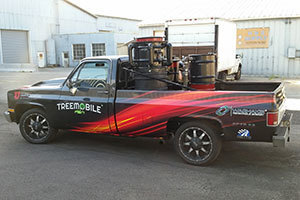
By the time Eric Eddings and Kevin Whitty got done modifying their black 1986 Chevrolet pickup to run on wood chips for a new undergraduate class, it looked like a shiny black, souped-up roadster – but with a touch of post-apocalyptic grunge from a “Mad Max” movie.
Eddings, a University of Utah chemical engineering professor and the College of Engineering’s associate dean for research, is an expert on combustion and fuels who also loves restoring cars. His colleague Whitty, a chemical engineering professor, is an authority on biomass fuels. Ten years ago, the two imagined what it would be like if they combined their interests into one inventive class. After a decade of busy schedules the two finally realized their dream, and the result was the university’s first wood-fired automobile class, a passion project in which 12 students were tasked with converting a truck from a gasoline guzzler into a vehicle that runs on wood pellets.
“We have a process that is called gasification where those wood pellets are partially oxidized, partially burnt … and it produces a gas that is still a fuel because it’s not completely burned to carbon dioxide and water,” Eddings explained. “It is primarily converted to carbon monoxide and hydrogen with some methane and minor hydrocarbons.”
The product of this gasification process is synthesis gas or “syngas,” a carbon-neutral fuel that will power the truck instead of gasoline. In order to do that, Whitty, Eddings and the students built a gasifier that sits on the bed of the truck. Modified 55-gallon drums were used — one for the hopper and gasifier that will contain and burn the wood pellets, and another for a heat exchanger that cools the gas.
The newly-created fuel then goes through a second heat exchanger to take out water, and a third barrel is used to filter out particulates such as ash. The gas is then clean enough to go through PVC pipes to the truck’s engine.
Work on the gasifier and truck was funded by a donation from Washakie Renewable Energy, along with equipment donated by Opto 22. The project was being carried out at the university’s Industrial Combustion & Gasification Research Facility in Salt Lake City. The facility’s director, Andrew Fry, also taught the class with Eddings and Whitty, and the trio received help from two visiting scholars from Hungary, Zsolt Dobo and Helga Kovacs.
Whitty said wood-fired fuel is not a new process. “It’s actually been around since the 1800s. London used it for town gas. A lot of people in World War II were doing this exact type of project — converting their cars to operate on wood — because in Europe a lot of petroleum was going into the war effort.”
Running cars on wood chips is not practical, however. It’s messy and not efficient, but it is considered a sustainable fuel like other forms of agricultural waste where it is replenishable. Despite that, the professors realized the one-year class would be an innovative way to teach students the gasification process as well as working together on a big project, one of the most important skills in the workplace. Along the way, they also learned about project management, scheduling, budgets, adversity and computer-aided design.
“For undergraduate engineers in particular, a lot of their courses are often fairly prescribed,” Eddings said. “But this is one really large project where they work in teams . . . and they’re learning if one team falls behind it impacts everyone else. That is very much a mirror of what life will be like when they get out into industry.”
The students finished converting the truck near the end of the 2015 school year, and are now making tweaks to take it to the Miller Motorsports Park in Tooele to see how fast it can go. Their goal: to beat the world record for a wood-gas vehicle set in 2011 on the Bonneville Salt Flats when a truck reached 73 mph. They hope to drive it on the track sometime next month.
Regardless of how fast their truck goes, Whitty says they plan to continue teaching the class. Future students can improve the design of the gasifier by making it smaller, more efficient and more powerful.
“We will start from where we left off with this. We are not going to build a whole new car,” he said. “But we could teach this class for 20 years.”